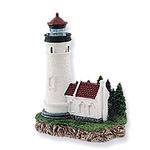Add Product Review
Tell us what you think about this item and share your experience with others. Please include only information that is relevant to the item you are reviewing.
Heceta Head, Oregon

The "This Little Light of Mine" series by Harbour Lights are miniature versions of the Harbor Light's lighthouses
When God created the earth, He spent a little extra time on the Oregon Coast. And it's as if He placed Heceta Head Lighthouse there Himself. It's magical.
Heceta Head Lighthouse is located on a breathtaking bluff 150 feet above the sea. It is one of the most visited lighthouses in the United States drawing thousands of visitors each year to sense its history, feel its romantic aura, and enjoy its spectacular view.
In 1775, Don Bruno Heceta, sailing for the Royal Spanish Navy, set out from San Blas, Mexico with 45 men and provisions for a year-long mission to reach the Arctic Circle and claim points en route for Spain. He made it as far as the Columbia River, before turning back due to concern for his sailors who were stricken with scurvy. On his journey he noted the headland, which now bears his name.
It's hard to imagine, looking at the site today with its sweeping Northwest forests, that there was very little vegetation when the lighthouse was constructed. A forest fire had swept through the area a few years earlier wiping everything out. The barren landscape can be seen in the photograph at right(used by permission of Western Washington University), which shows the lighthouse and the keeper's dwelling through the Needle's Eye.
Construction of the lighthouse began in 1892. Lumber came from local mills, the masonry and cement came from San Francisco, and rock used in the base of the tower was quarried from the Clackamas River near Oregon City. Laborers were paid $2 a day and worked an average of ten hours a day. The highest paid carpenter received $4 a day.
The tower is 56 feet tall with a focal plane of 205 feet above sea level. The most powerful light along the Oregon coast, the light can be seen 21 miles out to sea and is only stopped by the curvature of the earth.
The first-order Fresnel lens was manufactured by Chance Brothers of Bermingham (Smethwick), England whose lenses were also installed at Point Cabrillo, CA, and Staten Island, NY among other places. The lens contains eight panels, with 640 prisms, each 2 inches thick.
The light shown for the first time on March 30, 1894, lit by Andrew Hald, the first headkeeper.
It has only failed on one occasion. On February 12, 1961 a rock slide caused by heavy rains snapped the electric wires leading to the station. When the generator failed, Keeper Oswald Allik and two coast guard assistants employed an Aladdin lamp and turned the lens by hand, by walking around the interior of the lamp room. They kept their vigil from midnight until 7:30 the next morning.
Over time, the rotation mechanism wore out and the lens leaned nearly six inches. The Coast Guard proposed deactivating the Fresnel lens, but after a public outcry the Coast Guard agreed to repair the lens. The giant lens was stopped in June 2000, and carefully removed. It was only the second time in the 106-year history of the lighthouse the lens had stopped. For nearly a year, a team worked on the restoration project. The light was reactivated March 15, 2001.
Originally there was a single dwelling for the headkeeper and a duplex for the two assistants. The single dwelling was razed in 1940. The Alpha-Bit Café in Mapleton, Oregon, 14 miles east of Florence, was built with the salvaged lumber.
The remaining duplex, known as "Heceta House," was leased by Lane Community College for a time after the lighthouse became automated in 1963. Currently it is a renowned Bed and Breakfast, which serves an incredible seven-course gourmet breakfast. The B&B has become so popular that there is at least a three-month waiting list.
Though the lighthouse tower is not haunted, stories have abounded for years of weird unexplained occurrences at Heceta House. It has been called one of the ten most haunted houses in the United States. Nearly all the residents since the 1950s have reported unusual incidents. But don't be spooked. "Rue" can be quite pleasant, sweeping up glass, exchanging a silk stocking for rat poison. The current keepers say that even today, guests report friendly encounters with Rue. No one seems to mind her at all.
When the Coast Guard agreed to repair the lens, continued maintenance of the lighthouse was turned over to the state parks department. Devil's Elbow State Park, which included the cove south of the lighthouse, was enlarged to include the lighthouse and was renamed Heceta Head Lighthouse State Scenic Viewpoint. Besides, the place is just too heavenly to have the devil associated with it.
In 2009, the Fresnel lens was deactivated for three months as some of the eight brass carriage wheels that rotate the lens were not touching the bed on which they ride. Experts thought the lens was at risk of tipping over so Florida-based Lighthouse Lamping was contracted at a cost of $22,000 to rectify the situation. The lens was reactivated on May 20th, in time to delight the expected summertime visitors.
In the park, the tides ebb and flow. The seabirds cackle, the wind whistles through the trees. There are peaceful sunrises and glorious sunsets. An occasional spectacular storm. Heceta Head Lighthouse watches over it all, faithfully casting its glistening beam over the sea. It truly is magical.






